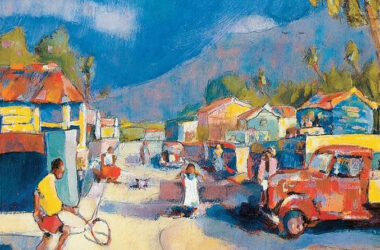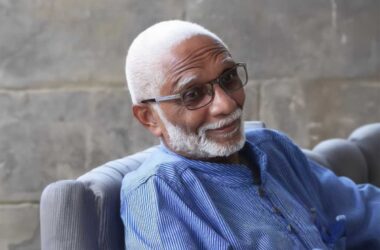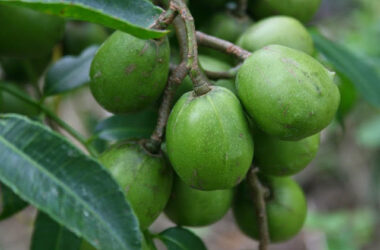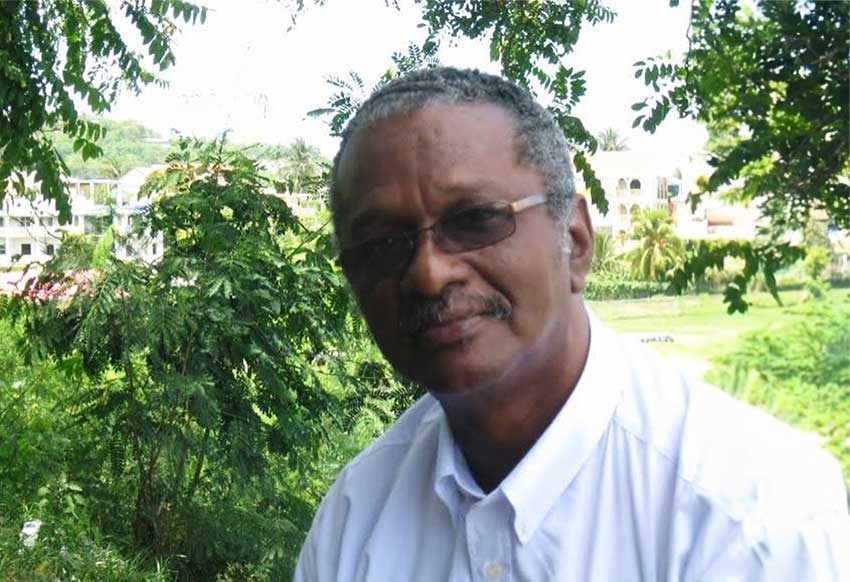
CWP: George Goddard, you are a Saint Lucian writer, but for many years you worked as a trade unionist. In your younger years you were part of something called Workers Revolutionary Movement (WRM), a left-of-centre pressure group, that was probably heavily influenced by Marxism. Today you are a member of the inner council of the Saint Lucia Labour Party. How have those non-literary, non-arts interests shaped your perspectives of Saint Lucia, the Caribbean and the wider world?
George Goddard: A number of historical streams and their confluences influenced the development of my world view. At the time, late 1960’s and 70’s and perhaps into the 80’s: the national liberation and decolonisation movements which had been unfolding in Africa, Asia and the Caribbean for more than three decades – in Latin America as well, where the struggle for independence and Spanish colonisation had been on-going from the turn of the 19th into the 20th Centuries, were gathering momentum.
The Civil Rights Movement in the United States and its Black Power off-shoot was also of particular influence, especially as it helped shape the thinking of Caribbean political activists, artists, writers and intellectuals. In the Caribbean, the engagement of Cuba, Haiti, Santo Domingo and many Central and South American political and social movements with a struggle against an emerging imperial power to the North was also a formative factor. The social movement of Rastafari was significantly in that milieu.
These different but related currents provided the context for the development of my world view, as they did for those of many young activists and thinkers across the Caribbean during the second half of the last century. This was fertile ground for the many variants of left ideologies that emerged — including Marxist philosophical perspectives.
For me the Marxist theory of Historical Materialism helped explain colonial oppression and provided the framework within which we might create a society that would work towards the eventual elimination of the worst characteristics of the scourges of exploitation and inequality. And within which the matter of our emancipation was to continue. Of course another stream was the labour movement which came under social democratic influences, but also influences that were allied to an imperialistic agenda.
My involvement in the left of this spectrum and the Saint Lucia Labour Party is thus explained. I saw these social imperatives happening within the context of a political architecture that was more people-oriented than what was handed down to us by the British.
As a young writer these ideas shaped my literary engagement with Saint Lucia, the Caribbean and ultimately the issues of the wider world.
CWP: In your earlier writing years your most popular poem was one written in Saint Lucian Kwéyòl titled Fig Vèt. You seem to have dropped out of sight for a while as a writer after that, but in recent years, you have appeared again, very strongly, with one collection of poetry and another due this year. You also write regular reviews on Saint Lucian literature which are published in print and online journals in the Caribbean and beyond. Alongside your trade union and political interests, Saint Lucian culture and especially the Kwéyòl language are also predominant in your concerns and strongly reflected in your writing. Why are those political and cultural themes and concerns of such importance for you?
GG: The imperative to engage against imperial and colonial domination and dehumanisation, is at the same time to define who we are as a people. It became clear to me that this self-definition had to find a praxis that had its roots and references in our culture — which was not to negate a broader world perspective. Which was to link the Caribbean with the broader struggles of oppressed people world-wide but which would root itself in the particularities of our culture and colonial experiences — which I learnt later that Amilcar Cabral would characterise as “returning to the source”.
Hence my first poem in Kwéyòl. It was a lament, but stronger than a mere lament, it was a polemic in the language of our people regarding the deprivation of plantation life. The poem “Fig Vèt” came more or less naturally out of these considerations, as well as from my experiences of life in the Mabouya and Roseau Valleys as plantation economy impacted the workers on the large estates and subsistence farmers.
The resonance of this terse poem, which was also published in Lamentin, Martinique, was because it drew from the wellspring of Saint Lucian culture and the Kwéyòl language — a language of resistance that we share with a number of formerly colonised and enslaved people (peoples colonised by the French).
Many of my poems since Fig Vèt engage with issues of hunger, malnutrition, disease, the oppression of women and girls, worker oppression. ‘Woman, Roseau Valley’, published in my Interstice collection, is one of these.
I would like to note here, that our Caribbean registers have been important in my poetry, because of the images, rhythms, sounds they evoke and invoke; the mood and the vibe in their related rituals allow an authentic telling of our story that cannot happen outside of these forms. Kont, Débòt, Lakonmet at La Kayè, Mabouya Valley where I grew up. The voice of Chantwèl Silou Sumayah, the goatskin drum of Tanbouwè Giltonn are always very present even when it seems that one is writing in standard English.
CWP: You returned to the literary spotlight in 2016 with your well received collection of poems titled Interstice, locally published and printed in Saint Lucia. In her review, Nahdjla Bailey had described the compilation as “effective poems.” She praised how the “poetry and memory were profoundly intertwined”, how “memories become poems” which then “enhance the poet’s memory of those experiences.” In that first collection, you evoke in many poems, early childhood memories of rural Saint Lucian life as well as memories of first loves, all quite graphically. But you also evoke Fanon and Sartre, Rwanda and Palestine (again in today’s headlines). You do not separate your meditations on an older Saint Lucia, present day realities of your island as well as the wider international examples of various imperial and military oppressions. What guides that kind of inclusive and larger perspective of our place in the world, with our past and present history and culture, and our standing as an independent nation?
GG: I dropped out of literary sight — as you have put it — in the mid-seventies, I had published my first poem, At Beanefield, in a Saint Lucian literary magazine, Link. It was a poem of youthful love and a bit more. During this period, I was not writing prolifically but was engaged more in political activism. You have mentioned WRM. I was doing some writing however, especially regarding environmental degradation and the loss of our patrimony — which were in fact very poignant political issues, and still are. Both of these linked with a not very well thought out rush into Tourism and related “development”. The poems, Marina and Lines On A Flight, both published in my 2016 collection reflect this period.
Environmental degradation, trampling of patrimony and cultural erasure remain a very present concern. And a more recent poem in my soon to be published collection reflects this. The poem is titled Lines at Cas-En-Bas.
Yes, and going to Fanon and Sartre: I had been reading these luminaries, but not only these. There were Aime Césaire, CLR James, VS Naipaul. There were also Walcott, Kamau Brathwaite, Pablo Neruda and Nicolas Guillen. I became increasingly convinced of the importance of carving out our space in the world and of the role of cultural expression in this. Walcott’s Star Apple Kingdom made a lasting impression on me.
Despite our relegation to the periphery of capitalist development we could not accept the position of some of our then leaders that, to take positions on the critical issues of human development and to risk the ire of great powers, was nothing but futile posturing on the world stage. In fact, it occurred to me that, many of our more conscious leaders (as many of our writers) had in an earlier period carried the message of claiming our space in the world; and that it was incumbent on this continuing line to carry on. Art cannot be this innocuous, sterile pastime that recoils from engaging with the real world.
These, among other considerations, guide a more universal perspective. That such a perspective is necessary has been borne out by events on the African continent and the continuing colonial project in Palestine. Colonial and Neo-colonial resource-grabbing is still alive — but hopefully not well. It continues to be supported and enabled by the very ones who spearheaded it in the 17th to 20th Centuries. For them it is the clawing back of the gains that the national liberation movements have made.
Poets, writers, cultural workers have a critical role to play at this juncture of history when the so-called 4th estate in the form of the corporate media has been co-opted by the agents of liberal democracy and other conduits of neo-colonial continuance.
Artists in the Global South cannot afford to have our heads hazed and misted in the cloud of new forms of oppression. Our muse must be one whose feet are firmly planted on the ground.
Let the Flute Lead Your Spirit… Kité Flit-La Mennen Lèspwi’w
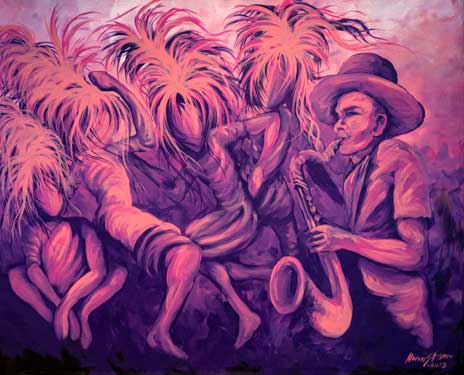
CWP: Your forthcoming book Let the flute lead your spirit/Kité flit-la Mennen Lèspwi’w explores our African roots and culture in a way you have not done before. You collaborate with Saint Lucian painter Alwyn St. Omer who has produced a number of monochromatic drawings of masqueraders. And these from the older tradition, which probably died out during the sixties. There has been a revival of the masquerade tradition, its music and costumes in recent years. But you and Alwyn are offering meditations on the older forms, more terrifying in many ways (like the parallel New Year’s tradition of Papa Djab, also now dead, in spite of the newer, more manicured versions) than the more entertaining newer incarnations. Which have their place. But even more profoundly, you and St. Omer are seeing those older, former masqueraders (also appearing in Garth St. Omer’s novels) as remnants of religious and cultural traditions brought to the West by enslaved Africans. The art and ekphrastic poems memorialise the last days of those traditions, their fading authenticity, connecting them with long-lost memories of Africa and its spaces. What inspired this collaboration? What were you after as you responded to St. Omer’s art? How do you hope this work fits into, and contributes to, the literary traditions of Saint Lucia? And beyond?
GG: Alwyn and I go back to the 70’s when we were both employed with WINBAN (Windward Islands Banana Research Laboratory). There we discovered a certain confluence of thinking on matters of culture and its role in national development. This has now led to a collaboration in ‘Let the Flute Lead Your Spirit…Kité Flit-La Mennen Lespwi’w’.
When I encountered his paintings of the Moon Dancer series I wanted to write. It was refreshing. It went beyond what you have aptly described as the “newer manicured version of the masquerade” to evoke an authenticity that recalled our childhood experiences. But more importantly it helped evoke certain powerful emblems and metaphors. I immediately suggested this collaboration in ekphrasis — his paintings, my poetry. This joint undertaking has resulted in the latest collection of poetry.
So the revival of the masquerade is essentially a repackaging of the tradition for the entertainment of today’s audiences. But while it recalls the memory in a certain sense, the erosion of authenticity blurs the link to what it meant to our forebears, the link with the African Homeland through the flute and the drum as well as dance, the experience of a forced exodus and enslavement, a longing for escape to the wide-open savannahs of freedom. A longing for return and to define and name ourselves. This ritual is an emblem of the yearning for a life beyond what some like Dionne Brand have called, ‘the door of no return’.
And this is what Alwyn and I are attempting to recapture — to rekindle. We explore in painting and verse, this form of street theatre and dance that is more than theatre and dance. Throughout the ten “Dances” that comprise the first part of the collection, I return to the themes of a “frustrated choreography”, “the phantasm of return” that mystifies the likelihood of the dreamt-of return, the arthritic limbs that struggle to carry the dancer beyond “the door”. But there is also the suggestion that a people who have suffered genocide, oppression, enslavement and the indignities of indenture can reach beyond the door.
That concept of going beyond the door of no return to create something authentically Caribbean suggested that I could treat the theme of African Heritage, with all its nuances, from a philosophical perspective that allowed for a people in our own right, creating our own path, despite the limitations that the metropole had assumed our history had imposed.
I am firm in the belief that like a potter (evoking the ancient Kalinago potters) we may “craft a work conceived in the womb / of continents and born to the gods of these islands of the sea.” We craft that work as well through “a narrative on the tongue / that does not speak with the tongues of Europe or Asia or Africa / but in all these tongues and in new words that are ours” (Les Raconteurs). Thus “word” and “art” become the flesh of that new Caribbean reality beyond the door.
So we are not bound to a mythical past when we were all kings and queens but we break out of “this circumscribing of islands [to] inhabit / the spaces of continents, navigate / nebulae and open the books of our names / to the limitless lumière of a strident star / our steps no longer timid, no longer / tentative, ponderous, uncertain — / no longer weighed down by tablets of stone / given at Olympus and all their High Mountains” (from Being Islanders, Let the Flute Lead Your Spirit…)
In this vein, Alwyn and I seek to tell our story and to continue the commitment of Walcott and Dunstan St. Omer (Alwyn’s father) to name our world because, to paraphrase Fanon, we have the word.
CWP: Saint Lucia and Caribbean literature are still dominated by writers like Walcott, Brathwaite, Naipaul, Carter among many others. These days of course, contemporary Caribbean writers are well known names. In Saint Lucia, we have had a well-recognised literary tradition, topped by Derek Walcott and his generation, with several of our writers now published by international publishers. How do you see your work, its styles, its concerns with using the Kwéyòl language, its political perspectives, making its own unique contribution to well-respected Saint Lucian literature, and indeed beyond? You have also been doing much reviewing of local literature which makes its own important contribution to critical examination of what is happening. How does your reviewing complement your other creative writing?
GG: I suppose that by now one may be able to look at my work and see certain recurring lyrical patterns and styles. It is not something I have given much thought to. In my use of Kwéyòl however, whether in a poem wholly written in the language or one in which it is used to counterpoint ideas expressed in English I am exploring the literary possibilities of the language and not limiting myself to narrow renderings. Too often the larger usages and nuances of Saint Lucian Kwéyòl have been obscured in an approach which has regarded it as a medium in which to express the trite and the inelegant.
Its literary development, I think, should however explore it as an increasingly effective medium of discourse among the several Kwéyòl speaking peoples first in the Caribbean, and then further afield. In my poetry and writing therefore I tend to move towards this. Very often this leads to expressions, idioms etc. which are not so current in Saint Lucia now but which are in wide usage by our neighbours. So, I’m not writing only for Saint Lucia: I’m writing for Guadeloupe, Martinique, Dominica etc. In so doing we are stemming the effects of cultural erasure.
On the matter of how my reviews complement my other creative writing: they help hone one’s artistic and intellectual insights. You are led to examine your own work through the prism of the work of others. Reviewing the works of other writers undoubtedly helps replenish the creative spring from which your muse drinks.
CWP: Finally George, any final thoughts for us on Saint Lucian and Caribbean literature, past and present, as well as how you see the Caribbean today in the present turbulent geo-political atmosphere? And what next for you in terms of publications?
GG: Caribbean Literature is making its mark in the world. I don’t think I’m being presumptuous in saying that it is punching above its weight. With publishers like Peepal Tree and Papillotte Press the trail that Walcott, Martin Carter, V.S. Naipaul, Kamau Brathwaite and our other forebears have blazed is being ably supported.
The philosophical underpinnings are being honed. There will be many streams. There will be differences and ideological departures in the discourse. Differences in how we see our Caribbean-ness. Immediately coming to mind are those between Naipaul and Walcott as well as some of the differences in the outlooks of some not as well-known writers discussed by Gordon Rohlehr in his “My Strangled City & Other Essays”. But Caribbean literature is developing into a body of work that the world can no longer ignore — and precisely because of the broad spectrum of views that contribute toward defining ourselves, rather than being defined by others
Jamaica Kincaid, Kwame Dawes, Kei Miller, Dionne Brand, Canisia Lubrin and Claudia Rankine certainly cannot be ignored. And neither can Mac Donald Dixon, John Robert Lee, Kendel Hippolyte, Jane King, Vladimir Lucien and George ‘Fish’ Alphonse among others.
With respect to the geopolitical issues in the Caribbean, our leaders and artists are uniquely placed as the region makes its presence felt in its contribution to world culture and literature, to help awaken the conscience of that world. And this is so precisely because of our more than 400 years of struggle to end oppression. Great Power oppression is not only present in Palestine. It continues right here in the relations of a more powerful neighbour with some of our countries, resulting in social degradation and economic deprivation. The recent example of South Africa’s leadership on the atrocities in Gaza is exemplary — they have lived apartheid and human degradation so their being out front is powerful. It is about human dignity in this Caribbean that has suffered so much.
As to where-to regarding future publications: I am looking forward to putting together a collection of my reviews of Saint Lucian writing in the near future; I have also been working on a manuscript of new and selected poems. So, George Goddard is back. No more dropping out of sight.
CWP: Thank you George Goddard.


